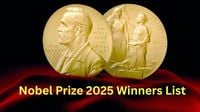The Nobel Prize season is always a highlight on the global calendar, drawing the attention of scientists, writers, diplomats, and curious onlookers alike. In 2025, the tradition continues with a flurry of announcements from Stockholm and Oslo, celebrating those whose work has made an extraordinary impact on humanity. As the world tunes in, the stories behind the prizes, the people who win them, and the legacy of Alfred Nobel himself come to life once again.
The Nobel Prize in Physiology or Medicine kicked off the 2025 awards on October 6, with the Nobel Assembly at the Karolinska Institutet in Solna honoring three remarkable scientists: Mary E. Brunkow, Fred Ramsdell, and Shimon Sakaguchi. According to coverage in The Economic Times and other outlets, these laureates were recognized "for their discoveries concerning peripheral immune tolerance that prevents the immune system from harming the body." Their work has not only laid the foundation for a new field of research but has also paved the way for innovative treatments for cancer and autoimmune diseases. As the Nobel Prize organization itself put it, their discoveries have "spurred the development of new treatments, for example for cancer and autoimmune diseases."
Just a day later, on October 7, the Royal Swedish Academy of Sciences announced the Nobel Prize in Physics. This year, the honor went jointly to John Clarke, Michel H. Devoret, and John M. Martinis. The trio was recognized "for the discovery of macroscopic quantum mechanical tunnelling and energy quantisation in an electric circuit." Their groundbreaking work has deepened our understanding of quantum phenomena in electrical systems—an area that, while sounding esoteric, could have far-reaching implications for the future of computation and technology. As noted by the Nobel Prize committee, these discoveries represent "groundbreaking discoveries in nature and the universe."
The excitement doesn’t stop there. The Chemistry Prize, always a closely watched event, is scheduled for Wednesday, October 8, 2025, at 11:45 CEST, with the presentation taking place at the Session Hall of the Royal Swedish Academy of Sciences in Stockholm. While the recipients have yet to be announced, anticipation is high as the scientific community waits to see who will join the ranks of Nobel laureates this year.
The Nobel announcements continue through the week: Literature on Thursday, October 9; the Peace Prize on Friday, October 10; and finally, the Nobel Memorial Prize in Economic Sciences on Monday, October 13. Each of these awards is presented by a different institution, reflecting the diverse legacy envisioned by Alfred Nobel himself.
Since their inception, the Nobel Prizes have represented the pinnacle of achievement in their respective fields. The first prizes were awarded in 1901, five years after Nobel’s death in 1896. Alfred Nobel, born in 1833 in Stockholm, was a prolific inventor with 355 patents to his name—including, most famously, dynamite. According to The Economic Times, Nobel’s motivation for establishing the prizes was, in part, a response to reading a premature obituary that dubbed him the "Merchant of Death." Determined to leave a positive legacy, Nobel dedicated 94% of his fortune in his 1895 will to create a fund for the Nobel Prizes, a move that would change the world of science, literature, and peace forever.
Today, the Nobel Prizes are awarded in six categories: Physics, Chemistry, Physiology or Medicine, Literature, Peace, and Economic Sciences. The last of these, the Sveriges Riksbank Prize in Economic Sciences, was introduced in 1969 by Sweden’s central bank in Nobel’s honor. Each prize can be shared by up to three individuals (except for the Peace Prize, which can also be awarded to organizations), and each laureate receives a gold medal, a unique diploma, and a cash award. In 2023, the monetary prize stood at approximately 11 million Swedish kronor—over 1 million USD.
The Nobel medals themselves are works of art, featuring an image of Alfred Nobel. The reverse side varies depending on the awarding institution. As a nod to tradition, the literature diploma is still written on parchment and created using techniques reminiscent of medieval illustrators, making each diploma a unique piece of history in its own right.
Over the past 124 years, the Nobel Prizes and the Sveriges Riksbank Prize in Economic Sciences have been awarded 621 times to more than 1,000 individuals and organizations. Some recipients, such as Marie Curie and the International Committee of the Red Cross, have received the honor more than once. According to The Economic Times, the Nobel Prize in Physiology or Medicine alone has been awarded 115 times to 229 laureates between 1901 and 2024.
The impact of the Nobel Prizes is hard to overstate. They encourage innovation, discovery, and peace-building efforts, honoring work that improves human life and society. The recognition not only brings prestige but also inspires future generations of scientists, writers, and leaders to push the boundaries of what’s possible. As the Nobel Prize committee notes, these awards "honour work that improves human life and society" and "inspire future generations."
For many, winning a Nobel Prize is the ultimate achievement—a moment that marks a lifetime’s dedication and often, a turning point for their field. The 2025 laureates in medicine and physics have already joined this storied company, and soon, new names will be added as the chemistry, literature, peace, and economics prizes are revealed.
As the world watches the announcements unfold, it’s worth remembering the spirit of Alfred Nobel’s original vision: to reward those who "confer the greatest benefit on mankind." In a world often divided by conflict and competition, the Nobel Prizes offer a rare moment of unity, celebrating the best of human endeavor and the enduring power of ideas to change the world.
With each medal awarded and each name called, the Nobel tradition continues—reminding us all of the heights to which humanity can aspire.




